Mark Sisson's Blog, page 340
May 7, 2013
15 Tips for Standup Workstation Users
 A lot of people who embrace the standup workstation thing think the work stops once you stand up. Sitting is hard, standing is easy – right? I don’t blame them, because I was the same way when I began incorporating the standup workstation. But, like barefoot runners who toss the shoes and rush into 10ks and marathons and end up injuring themselves, workers who ditch the chairs and spend full workdays on their feet without thinking about how to stand often end up in pain. They don’t realize what kind of stress standing – often in the same place – for hours at a time can place on their bodies. It’s not enough to just stand. You have to do it right, and you have to make adjustments and move and stay on top of things to do it right.
A lot of people who embrace the standup workstation thing think the work stops once you stand up. Sitting is hard, standing is easy – right? I don’t blame them, because I was the same way when I began incorporating the standup workstation. But, like barefoot runners who toss the shoes and rush into 10ks and marathons and end up injuring themselves, workers who ditch the chairs and spend full workdays on their feet without thinking about how to stand often end up in pain. They don’t realize what kind of stress standing – often in the same place – for hours at a time can place on their bodies. It’s not enough to just stand. You have to do it right, and you have to make adjustments and move and stay on top of things to do it right.
Throughout my many years of standing up while working at a desk, I’ve picked up a few tips that make things go a little more smoothly. If you’re interested in hearing, read on:
Stand correctly.
Standing takes skill, particularly if you’re not really used to doing it correctly in the first place. Standing up to work doesn’t help much if your hips are jutting forward and your lower back is overextended. Standing up to work isn’t much better than sitting if you’re doing the model pose with most of your weight on a single hip. Leaning over the table and resting on your elbows isn’t really correct, either. You need to stand the right way. Here’s what I picked up from Kelly Starrett regarding attaining proper standing posture:
Your toes should be pointed forward, rather than duckfooted, and your feet should be “screwed” into the ground. Lightly squeeze your glutes and “activate” your abs to align your posture. Don’t flex – you’re not posing – but keep everything engaged. Do these things, and your posture should naturally improve. Do these things consistently, and your improved posture will become second nature.
Do shoulder rolls.
Computers have brought many benefits, but they have also created an entire generation of forward protruding heads placed atop internally-rotated, hunched, slumped shoulders. Though this position is improved upon by standing up to work at the computer, it doesn’t necessarily fix it if you don’t pay attention to the placement of your shoulders. One of my favorite ways to realign a slumping shoulder is the shoulder roll.
I picked the shoulder roll up from Esther Gokhale, the traditional posture expert. It takes ten seconds to perform, max, and consists of moving your shoulder forward, up, as far back as possible, and then allowing your shoulder blade to slide gently down your spine. Repeat for the other shoulder. Do this every time you find your shoulders slumping forward. Eventually, your shoulders will begin to naturally rest in a more retracted, stable position.
Here’s a good explanation (PDF) of it, and here’s a helpful video demonstrating it.
Check your ergonomics.
The Occupational Health and Safety Association has released ergonomics standards for standing workers. Read them, and integrate them.
Don’t make any egregious errors, like having the keyboard at chest height or the monitor positioned such that you have to crane your neck back to see.
Go for a short jaunt every hour.
Walking’s not just for chair jockeys. Being immobile – even when standing – just isn’t as good as walking.
So go for a walk. Not necessarily a long walk, but try to do five minutes of walking every hour.
Elevate one foot.
If you find your back getting stiff, it can sometimes help to elevate one foot by placing it on a chair, a stool, or even a desk. That’s why bars typically have foot rests for patrons.
Some people see this as cheating, but I see it as a helpful workaround. A tool to be levied in the service of your improved health and decreased pain. Don’t rely on it, but it’s nice to have.
Practice your squat.
Look, you’re already standing. Your feet are already on the ground. Why not practice your Grok squat? When hunter-gatherers and other non-industrialized, sedentary people just need to chill out, they generally don’t just stand around. They squat. The squat is relaxing for them, a position of repose. Can you say the same? Probably not. Now’s your chance to make it so.
If you want to turn this into a workout, fine. Personally, I think the focus should be on getting comfortable in the hole, on making the full (or as close to full as you can manage) squat feel normal for you. It will alleviate stress on your lower back, too, if you have any issues there, as well as keep you mobile and perma-warmed up for any physical endeavors.
Do some mobility exercises.
Being on your feet affords you the opportunity to move with purpose and improve your mobility throughout the day. You can peruse Mobility WOD for ideas on what to work on, or check out my previous posts on mobility, but my personal favorite is the VitaMove routine from Angelo dela Cruz. The beauty of VitaMoves is that you need no equipment, no props, and there are no time limits. You just do what you feel like doing. Heck, Angelo himself recommends that instead of doing the entire routine all in one go, which can be a bit daunting at first, people choose one movement to practice each day.
Check out the routine and see what you like.
Fidget.
Just because you’re standing doesn’t negate the need for frequent movement. Standing is better than sitting, all else being equal, but you still need to move your body. My favorite mode of non-planned, spontaneous movement is the fidget. The fidget’s great. You don’t need to plan anything. There are no sets, no reps. Fidgeting comes quite naturally, probably because it’s subconscious. You don’t even really have to do anything. Instead, you just allow it to happen.
Not to be confused with twitching.
Grease the groove.
I’ve spoken about this before. Greasing the groove is performing a movement – like a pullup or a deadlift – as many times as possible without reaching fatigue. It allows you to practice a movement and develop excellent muscle memory so that doing it becomes second nature. If you’re greasing the groove with pullups, doing short sets of pullups frequently throughout the day, you’ll increase the number of pullups you can perform without ever really getting fatigued.
Choose an exercise that you can perform while standing. Pullups are a great choice, obviously, but require a horizontal bar or ledge capable of supporting your weight. Pushups, squats, or even kettlebell swings work well in an office setting. Throughout the day, hit lots of short sets. You can set up an interval timer (set to go off every fifteen minutes or so) or just remember to get a set in every so often.
Keep a weighted object in the office.
I’m not expecting you to keep a loaded barbell in the room, although that would be awesome. Just have something in the office that’s reasonably heavy (enough to provide a bit of a challenge) and familiar to you (you should know how to use it safely). Then use it to do exercises throughout the day.
Kettlebells are perfect for this. They are compact enough to fit in a corner unobtrusively, like little bowling balls with handles, and you can do dozens of different exercises with them. Swings, snatches, cleans, presses, rows, deadlifts, single leg deadlifts, single leg single arm deadlifts, and the list goes on. You get the point. Other options include sandbags (that you’re confident will not leak), dumbbells, and slosh tubes. The aforementioned barbell also works, if you can swing it.
Plank.
No, not the outdated Internet fad. The exercise. Try to do a 30-60 second plank every other hour. Since maintaining a plank requires that you maintain a perfectly neutral spine, it will reinforce proper posture when you’re standing. Also, abs. It will give you nice abs, and that can’t hurt.
Upgrade to a walking workstation.
Walking is our birthright. It’s just what humans (are supposed to) do. Standing? It’s a little awkward – and novel – for us to be standing in place for long periods of time. If you don’t do it right, you can end up with niggling pains. Last year, I linked to Chris Kresser’s post on walking workstations and since then we’ve picked up four of the TreadDesks around the office, and the workers really love them. The TreadDesk is a standalone treadmill without handles that slides under just about any desk, effectively converting it into a walking workstation.
One big thing you miss out on when treadmill walking is glute activation. If you can create a slight incline, though, you’ll get some glute action.
Sit.
Standing to work is not an ideology. It’s supposed to make you feel better and keep you healthier and more mobile. Whatever works, works. The point with a lot of this is to break up the corporeal monotony. Just like the sitting worker should stand up and move around on a regular basis, the standing worker might want to take a load off from time to time. It might even be helpful or healthful to do so.
Have a chair, stool, or swiss ball on hand that you can use for sitting when the need strikes you.
Practice your running.
You might as well make the best of your time, you know? Instead of pausing to browse Facebook or Twitter for the twentieth time, try the 100-Up, a an old running technique from the 1800s that teaches you perfect form from the comfort of wherever you’re standing.
Shake things out.
Whenever I stand for a long time, I do a little routine to “shake things out.” It consists of two parts, both of which are meant to keep me loose and get me back to square one. If I’ve been getting stiff from an improper position, this always fixes me.
First, I make like a boxer and bounce on the balls of my feet, allowing my heels to touch down before I bounce back up. I almost look like I’m jump roping, except I never leave the ground. Just kinda bounce on your calves and allow the rest of your body to move freely. Your arms will be swinging around, your hands will be hitting your chest and shoulders and thighs. It might take a little practice to get the balance right, but once you do, it’s very relaxing.
Next, I keep my feet planted around shoulder width apart (whatever’s comfortable for you), toes pointing straight ahead, and rotate at the hips. Again, let your arms swing freely. Use your glutes to rotate your hips, and don’t move your feet. Just get loose. Your hands should make contact with your glutes on every backswing. If they don’t, you either have abnormally short arms or you’re staying too tight. You see kids doing this a lot. I think they know something we don’t.
I’ll do both or either of these once or twice a day, just to loosen up and relax.
Be sure to review my previous post on tips for desk jockeys. Many, if not all, of those entries can be applied to standing workers as well.
Well, that’s it. That’s what works for me. What about you? Do you standing workers out there have any tried and trued methods for making it work? Let us know in the comment section!
Get the Free 7-Day Course on the Primal Blueprint Fundamentals for Lifelong Health Delivered to Your Inbox

May 6, 2013
Dear Mark: Sleepy After Chicken, Microwaving Bone Broth, and Safest CAFO Meat
 It’s time for yet another edition of Dear Mark, and this time I’m covering some interesting topics. First up is the phenomenon of sleepiness following a meal of chicken with the skin on. Far from being an unwelcome, foggy sort of fatigue, this particular brand of sleepiness is pleasing. Could it be something in the chicken? Next, I discuss whether or not the proteins in bone broth are irreparably alerted – in a bad way – upon microwave exposure. I don’t come to an ironclad conclusion, but I do try to give some perspective on the issue. Finally, I try to decide on the “safest” CAFO meat to order when you’re unable to procure grass-fed or pastured.
It’s time for yet another edition of Dear Mark, and this time I’m covering some interesting topics. First up is the phenomenon of sleepiness following a meal of chicken with the skin on. Far from being an unwelcome, foggy sort of fatigue, this particular brand of sleepiness is pleasing. Could it be something in the chicken? Next, I discuss whether or not the proteins in bone broth are irreparably alerted – in a bad way – upon microwave exposure. I don’t come to an ironclad conclusion, but I do try to give some perspective on the issue. Finally, I try to decide on the “safest” CAFO meat to order when you’re unable to procure grass-fed or pastured.
Let’s go:
Hey Mark,
I love eating chicken, especially baked. I have noticed that after eating chicken meat with the skin I often feel pleasantly sleepy afterward. This is not a brain fog, food coma kind of tired. Just a nice tiredness. Do you know of anything about chicken that would cause this? Or is it just an association?
Thanks!
Sarah
As much as we criticize chicken for containing too many PUFAs – which is a valid point, especially if you rely on chicken for the bulk of your animal calories – chicken fat is actually quite high in oleic acid, the primary monounsaturated fat and the same one found and championed in olive oil, ranging from 37% to 56% of total fat. In fact, it’s the primary fatty acid in chicken fat.
In the body, oleic acid can be converted into oleamide, a fatty acid amide. Fatty acid amides are formed when a fatty acid combines with an amine, and they are used in chemical signaling within the body. Oleamide in particular has been fingered as a potent sleep-inducer:
During sleep deprivation, oleamide accumulates in the cerebrospinal fluid.
Both acute and sub-chronic administration of oleate increases REM sleep in rats. May they sleep well and dream of large blocks of cheese (points to whomever gets that reference).
Oleamide has been detected in humans, not just lab animals, and low oleic acid intake has been linked to sleep disorders among the depressed.
Beyond helping to regulate sleep, oleamide likely has other physiological roles. For one, it appears to inhibit the inflammatory effects of lipopolysaccharide, the toxin released by certain gut flora.
For a real nice sleep, try chicken soup. The glycine in gelatinous broth links up (in your body) with the oleic acid in chicken to form n-oleoylglycine, a bioactive precursor to oleamide with “chill-out” properties of its own. It’s not quite so simple as “eat chicken fat, make more oleamide,” but having more oleic acid in your diet should provide more substrate for oleamide synthesis, and thus inducement of sleep. Either way, it appears to be having an immediate effect on you. Even if my educated guess isn’t correct, enjoy the sleep!
You know, I’ve noticed this myself. Not just with chicken, but with pretty much any animal fat, which makes sense when you realize that animal fat almost invariably comes along with plenty of oleic acid. Beef fat? About 50% oleic. Pork fat? About 50% oleic. Lamb fat? Around 45% oleic. I wonder if olive oil (mostly oleic) will work, too, or if it’s something else in the animal fat that works in concert with the oleic acid. Interesting stuff. To find out the truth, just eat some animal fat before bed!
Seth Roberts has had similar experiences with animal fat (specifically pork fat) and sleep, for what it’s worth.
Speaking of broth…
Mark,
I just read your 4/24 post on how much protein should you eat. I followed a link from that to an article on the Weston A. Price site (Why Broth is Beautiful: Essential Roles for Proline, Glycine and Gelatin). One part of the article said that microwaving bone broth changes the proline in it from the trans to the cis form. This in turn causes ‘structural, functional and immunological changes’ in the body and can be nephrotoxic, and heptatotoxic. So, is this true?? Do you use a microwave to reheat broth? I have been, should I stop?
Kitty
That’s a great article, overall, which is why I linked to it, but I’m not very convinced on the dangers of microwaved bone broth.
Let’s assume microwaving turns the L-proline into D-proline. Should we be worried about D-proline? Is it truly toxic to the kidneys and liver?
There have been a number of animal studies examining the effects of the various proline isomers, and there are conflicting results.
In chickens, L-proline induced amnesia, while D-proline did not.
L-proline destroyed more hippocampal neurons than D-proline.
Among chicks, L-proline caused more pecking than D-proline. Pecking is often used as a marker of depression in chickens kept in close quarters with other chickens. Now that I think of it, though, I’m not so sure “increased tolerance of inhumane crowding” is such a good or normal thing. Depression appears to be warranted in the chicken’s situation!
When injected into a chicken’s heart, D-proline produced convulsions and death, while L-proline did not.
D-proline produced liver and kidney damage in rats, while L-proline did not.
There are also a few human studies, not on the effect of dietary D-proline, but rather highlighting the constant presence of D-proline in our guts and in our saliva:
Both D-proline and L-proline are found in human gastric juice. Furthermore, patients with gastric cancer and H. pylori infections tended to have higher levels of L-proline, but not D-proline, in their guts. It’s also present in our saliva independent of our dietary intake.
Does this mean broth should be microwaved in order to convert it into gut-protective D-proline? Does it mean that it should never be microwaved in order to protect us from liver lesioning D-proline? Of course not! I just wanted to highlight how depending on what research you use you could claim that D-proline is dangerous, deadly stuff that should be avoided at all costs, or you could call it neuro-protective and anti-depressant (at least for baby chicks).
Look, D-proline may be problematic. I really don’t know. And microwaving your broth may alter the proteins to make them dangerous. I don’t know. I don’t think it’s likely to cause severe issues in the way we consume broth. I mean, how often are you drinking broth, let alone broth that’s been heated in a microwave? Daily? Couple times a week? A tablespoon of gelatin, which contains just under a gram of proline, will gelatinize two cups of water, so you’ll be getting about that much (of potentially converted D-proline) every time you consume a couple cups of properly set broth.
I find that I don’t use the microwave all that often for broth, but that’s mainly because I like to add stuff to it and stir it in as it heats on the stove. I’ll usually throw in some sea salt, black pepper, and turmeric (and maybe some egg yolks) as it heats. And if I cook with broth, say to make a reduction. My latest kick is sautéing some garlic, shallots, and ginger in butter, adding a splash of white wine, reducing that, adding a cup of real broth to the pan, reducing that, and then add chopped pastured chicken livers to the mix until it forms a nice, livery (yet mild) gravy. Excellent, nutritious, and no chance of creating harmful amino acids.
I wouldn’t worry too much about microwaved broth, especially if that’s your only reliable way to get it. Whatever you do, don’t inject microwaved broth into your ventricles (either of them).
Dear Mark,
If I have to choose among CAFO beef, chicken, or pork, which is the least of the “evils”? I try to get grass-fed/pastured whenever possible, but that’s not always possible.
Thanks!
Goldie
“Cleanliness,” or the presence of various agricultural and/or industrial toxins in the meat.
CAFO animals eat industrially-produced feed, which means exposure to a fair amount of pesticides and other toxins. Do these show up in the actual meat, though? Let’s take a look at some average findings, according to the What’s on my Food? website.
Beef fat samples contained 10 pesticide residues, including significant amounts of DDE and dieldrin. DDE is a metabolite of DDT, and it’s been linked to impaired neurodevelopment in children, lower birth size, and chronic kidney disease, among other conditions. Dieldrin is an organochlorine insecticide banned in the US since 1987 that still manages to display remarkable persistence in the food supply, even biomagnifying – become more concentrated – as it moves up the food chain. 33% of samples contained DDE and 15% of samples contained dieldrin. Beef muscle meat and liver, however, were absent of pesticide residue.
Poultry fat contained no residues, whereas poultry thigh and breast both have been shown to contain detectable levels of eight and seven pesticides, respectively, though at a far lower rate than beef fat.
Residues from three pesticides have been found in pork meat, while pork fat has been shown to contain up to eight pesticides.
Winner: Lean beef or beef liver.
Fatty acid composition.
Since the ruminant is pretty resistant to dietary influence of its fatty acids, CAFO beef fat contains just 4% PUFA, with the rest being saturated and monounsaturated fat. That’s pretty solid. Too bad you’re missing out on the CLA content found in grass-fed beef, though.
Pork fat is decent in theory, but in practice – which includes the feeding of soy, corn, and related oils to pigs – the PUFA content of pork fat can get as high as 32%.
Chicken fat is PUFA-rich, and it’s getting even richer. Since 1980, the average linoleic acid content in chicken has increased by 2.6 times, while the omega-3 content has dropped even further. Nowadays, CAFO chicken fat is a bit like tasty vegetable oil.
Winner: Beef.
Antibiotic-resistant bacteria.
A new report found antibiotic resistant bacteria in 81% of ground turkey, 69% of raw pork chops, 55% of raw ground beef, and 39% of raw chicken parts. I know how much you all love your rare turkey burgers and medium rare chicken thighs, but it’s just not worth it. Beef seems to be the most risky here, for two reasons: grinding beef increases the surface area and spreads the bacteria evenly throughout; beef is often eaten rare, which keeps the bacteria alive. Sure, you’ve got the occasional crazy who demands his chicken thigh pink, but that’s pretty rare.
Winner: Chicken, which has the least resistant bacteria and tends to be well-cooked.
Quality of life.
While no CAFO animal lives a “good life,” some have it worse than others. Chickens live in crowded warehouses with tens of thousands of other chickens with no access to fresh air. Pigs live on concrete slabs, oftentimes in pens too small to turn around. Cows, on the other hand, typically start out on pasture before being transferred to feedlots. All animals suffer stress, but it seems obvious that cows suffer “less” than the others.
Winner: Beef, although I’m hesitant to call it a winner.
Overall? I’d say go for the lean CAFO steak. But if you don’t make this sort of thing a habit, go for whatever you want and enjoy it.
Thanks for reading, folks. Take care.
Subscribe to the Mark’s Daily Apple Newsletter and Get the Success Story in the Making eBook for Free

May 5, 2013
Weekend Link Love
 Research of the Week
Research of the WeekNew archaeological evidence suggests that 2.6 million year-old hominin scavenging strategy was characterized by “a strong focus on acquiring and exploiting fatty, nutrient-rich, energy-dense within-head food resources (e.g., brain matter, mandibular nerve and marrow, etc.).” And still somehow we lack the genetic adaptations for eating animals, apparently, and animal fat is still bad for us. Oh well, at least we have a great new genre of food: “energy-dense within-head.”
Researchers may have discovered an important factor in bee die-off: giving bees HFCS instead of honey impairs their natural ability to detoxify substances and activate their immune systems, thereby leaving them vulnerable to certain pesticides. Not a big surprise, really, but it’s still nice to have it confirmed.
Interesting Blog Posts
Ned Kock explores the potentially genetic proclivity toward belief in the supernatural among humans, as well as the beneficial effects on “self-healing” that it appears to mediate.
The definitive guide to the brain and body health benefits of being naked.
According to Peter Gray, the “play researcher,” the most basic and fundamental human right is the freedom to quit.
Media, Schmedia
Did a grade school science fair project just determine that celiac disease is more prevalent than previously thought?
Everything Else
Check out this gorgeous photograph of kids from the USSR getting their vitamin D in an interesting way.
Recipe Corner
Next time you’ve got a grill, some meat, a few pairs of swim trunks/bikinis, friends to wear them, and a body of swimmable water, make the watermelon mojito salad. Rum optional.
Pesto’s good, but it’s real easy to burn those pine nuts when you toast them. For a more robust – and less omega-6-intensive – pesto, use macadamia nuts.
Time Capsule
One year ago (May 5 – May 11)
Are Humans Hard-Wired to be Optimistic? – Are pessimists unnatural, soulless mutants? Just kidding.
Why We Don’t Sprint Anymore (plus a Primal Health Challenge) – Since people no longer have as many reasons to run really fast once in awhile, I provide a few.
Comment of the Week
“A new study finds that markers of long-term stress (hair cortisol) correlate just as strongly to cardiovascular disease as traditional CHD risk factors.”
So, conventional wisdom would dictate that cutting our hair will help us avoid heart disease… !
- And in truly dire situations, cardiologists will place heart disease patients on radiation therapy.
Get All Three Primal Cookbooks, an Apron and More in The Primal Blueprint Chef Kit Today!

May 4, 2013
Mushroom and Bacon “Risotto”
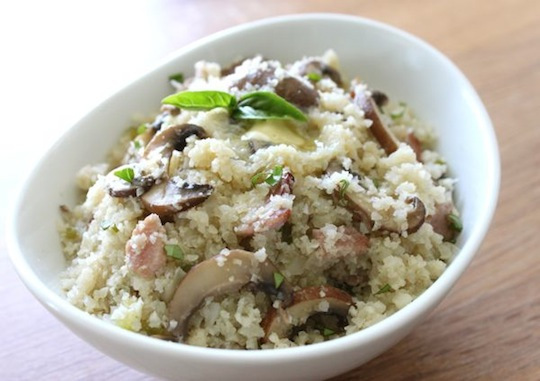 The rich flavors of bacon and mushrooms dominate this dish, turning riced cauliflower into a super-flavorful side. Cauliflower risotto is fantastic served with a main course of roasted chicken, salmon, or thick, juicy pork chops.
The rich flavors of bacon and mushrooms dominate this dish, turning riced cauliflower into a super-flavorful side. Cauliflower risotto is fantastic served with a main course of roasted chicken, salmon, or thick, juicy pork chops.
The recipe below is great without any additional ingredients, but if you’re really craving comfort food then fatten the risotto up a bit. Generous amounts of grated Parmigiano-Reggiano cheese or butter (or both) will do the trick. A garnish of fresh herbs like basil, parsley and chives add color and flavor.
Like traditional risotto, this dish shouldn’t be overcooked. Stop when the cauliflower is al dente. Otherwise, you’ll end up with a bowl of mush. Still flavorful, mind you, but lacking the crisp-tender texture that makes cauliflower risotto really good.
Servings: 4
Time in the Kitchen: 35 minutes
Ingredients:

2 heads of cauliflower, cut into small chunks (bottom stem and leaves trimmed off)
4 to 6 pieces of bacon, cut into small pieces
1 small yellow onion or large shallot, finely chopped
2 stalks of celery, finely chopped
2 garlic cloves, finely chopped or thinly sliced
3/4 pound mushrooms, sliced thinly (340 g)
1/2 cup chicken stock (120 ml)
Parmigiano-Reggiano cheese, butter, finely chopped fresh herbs (optional toppings)
Instructions:
In small batches, put the cauliflower chunks into a food processor. Process until the cauliflower has the consistency of rice. Set aside.
Cook the bacon in a wide pot or skillet over medium-high heat. After a few minutes add the onion/shallot, celery and garlic. If the bacon hasn’t released enough fat, add a little bit of olive oil or butter to the pot.
Sauté for 3 minutes then add the mushrooms. Sauté for 5 minutes more. Again, if the pot seems dry, add more olive oil or butter. Season the mushrooms lightly with salt and pepper.
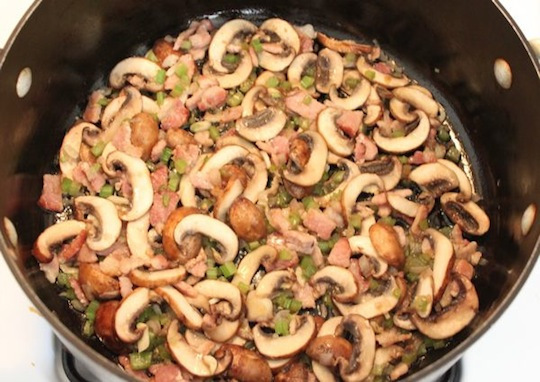
Add 8 cups of cauliflower rice. If you have slightly less than 8 cups, don’t worry about it. If you have more, reserve the extra for another meal.
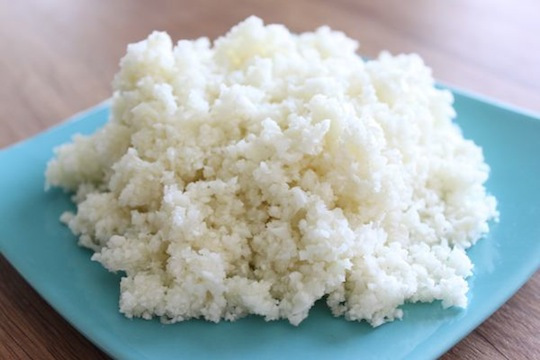
Add the chicken stock. Put a lid on the pot and cook the cauliflower for 5 to 7 minutes until tender but not completely mushy.
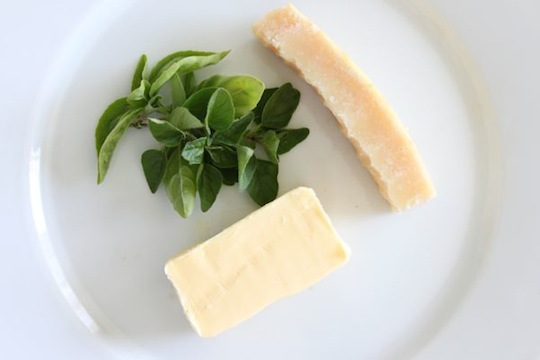
Before serving, flavor the risotto with generous amounts of one or more of the following: grated cheese, butter, fresh herbs.

Not Sure What to Eat? Get the Primal Blueprint Meal Plan for Shopping Lists and Recipes Delivered Directly to Your Inbox Each Week

May 3, 2013
Free at 50
It’s Friday, everyone! And that means another Primal Blueprint Real Life Story from a Mark’s Daily Apple reader. If you have your own success story and would like to share it with me and the Mark’s Daily Apple community please contact me here. I’ll continue to publish these each Friday as long as they keep coming in. Thank you for reading!
 I used to be your typical 98 pound weakling. When I graduated from high school in 1980, I tried to break 100 pounds but couldn’t. Tired of looking like a bag of bones, I joined a gym and started packing muscles on my frail frame. I discovered bodybuilding and began to gain some weight. Like most guys in the early 80’s, I was obsessed with getting big. Although, I never considered being a competitive bodybuilder since the thought of parading on a stage with the background music of “Eye of the Tiger” while sashaying with a sock-stuffed Speedo is way beyond embarrassing. I did embrace the lifestyle of a meathead: I spent 2 hours every day at the gym and stuffed my face with food and protein drinks continuously. By my mid-20’s I had gained almost 70 pounds, although I doubt it was all muscle. Along the way, I bought in to most of the myths that conventional wisdom had taught me, which actually made me fat and unhealthy.
I used to be your typical 98 pound weakling. When I graduated from high school in 1980, I tried to break 100 pounds but couldn’t. Tired of looking like a bag of bones, I joined a gym and started packing muscles on my frail frame. I discovered bodybuilding and began to gain some weight. Like most guys in the early 80’s, I was obsessed with getting big. Although, I never considered being a competitive bodybuilder since the thought of parading on a stage with the background music of “Eye of the Tiger” while sashaying with a sock-stuffed Speedo is way beyond embarrassing. I did embrace the lifestyle of a meathead: I spent 2 hours every day at the gym and stuffed my face with food and protein drinks continuously. By my mid-20’s I had gained almost 70 pounds, although I doubt it was all muscle. Along the way, I bought in to most of the myths that conventional wisdom had taught me, which actually made me fat and unhealthy.
By the time I reached my 30’s, I continued doing individual body part training. The false perception of single part training over total body training dominated my thinking and just about everybody’s at my gym. We kept on with our bicep curls, bench presses and leg press machines. And yes, I was brainwashed to believe that training with machines was superior to free weights. The thought of bodyweight training never even occurred to me. I was obsessed with trying to get huge and continue the art of force feeding myself every 2 hours. I got big, but in the wrong places – like my gut. I took up long distance running as way for me to lose the fat, since that was what all the health experts in the magazines said I should do. I really hated running, but it quickly became part of my workout regimen because it gave me an excuse to gorge out on spaghetti with clam sauce the night before my runs. I didn’t feel like I was doing anything wrong as I was just listening to all those running gurus on how to fuel my runs. Soon, I was not only carbing up before my runs, but before my weightlifting workouts – as if I needed the extra energy to sit down on the useless Nautilus lat machine. At that same time, my perception of myself was so distorted; I felt that the 7 mile runs three times a week were making me lose inches off my chest and shrinking my arms, so I continued bulking up with the same 6 meal a day plan that consisted of a lot of the famous tasteless and skinless chicken breast and fake protein drinks filled mostly with fructose and sugar. This was the 1990’s and just about everybody was afraid of fat because that’s what all are doctors told us. The fat-free craze and “the cholesterol is dangerous” phase really took off during this decade before Atkins came along and we all bought in to eating what we told were “healthier” foods like vegetable oils, bacon bits, and margarine. Looking back on now, I pretty much went about fifteen years without tasting butter.
So for about two decades I listened and did what all the fitness experts told me to do to get in shape which was individual body part and machine training, long distance running, high carbs and fat-free everything. Don’t let me get started on my brief self-experimentation with vegetarianism. You would think after taking all this professional advice, I would look great without a shirt on when I went to the beach which was two blocks from where I lived. But, I never went to the beach because I knew I would only embarrass myself. My biceps were okay, but considering I mostly did curls whenever I went to the gym, they should be. However, I also had a gut that made me look pregnant whenever I wore that skin tight shirt that was a size too small for me.
As I got to my mid-40’s, I was having health issues as my blood pressure skyrocketed. I still went to the gym, but by now I was pretty much going through the motions by only working out my arms and chest. I didn’t see the point of getting strong at my age, so I gave up squatting and deadlifting years ago. I also stopped running. My knees and shins were shot from all the heavy pounding I did while running through the streets of Los Angeles. I started getting really depressed as well because I spent months and months without even having a date. I pretty much felt that my attraction level had gone down the tube and I would end up being just another miserable old man living alone in his apartment walking around in his underwear.
I needed to do something drastic, or better yet, do the opposite of what everybody else was doing and what the so called experts were telling me to do. That’s when I discovered MDA. So instead of trying to get big like Arnold, I focused on whole body conditioning work and did the Primal workouts of the week and CrossFit and finally lost the weight.
However, I was still very neurotic about my eating habits as I was about 50 percent Primal at this time. I felt more compelled than ever to continue my carb loading and eat 6 times a day to fuel my high intensity training. Even though I was finally able to sever my adolescent needs to bulk up, I was still caught in this force feeding mode that I just couldn’t seem to escape. In my 20’s and 30’s I could do it, but when I got to my 40’s, it became such a pain in the ass and such an inconvenience for me. I was always looking at my watch to see if it was time for me to eat again. I couldn’t even go to the movies without having not only one but two meals packed with me. The constant planning of what to eat next, tomorrow, cooking 8 meals at once, nearly drove me bananas.
The worst part of all of it is that I kept on getting hurt. My friends, family and gym friends would all tell me that it is perfectly normal to be in pain as you get older. I have been pretty gullible my whole life, foolishly believing all the false health misinformation that was spoon fed to me without question. But, this belief of correlating pain with age was something I absolutely refused to believe and defiantly fought hard to disprove. I decided to be 100 percent Primal.
At this stage of my story, it’s been two years since I made a commitment to decreasing inflammation in my body. I would still get the occasional and normal aches from my training, but not like how I constantly felt before when I was eating grains, legumes and when I ate out a lot at restaurants where vegetable oil is the main culprit. I considered myself completely Primal, except I was still unable to break away from my eating disorder of the need to jam food down my throat.
At the beginning of last summer, while Diane and I were planning our road trip move from California to the east coast, I thought that might be a good time to throw in some intermittent fasting as I knew I wouldn’t dare let myself eat at all the truck stop food that’s laced with soybean oil. My decision to experiment with intermittent fasting would be my last frontier with the Primal lifestyle. The thought of not eating or even eating less than 6 meals a day seemed so out of the question to me, but I needed to prepare myself or starve to death during our 10 day car trip journey. To be honest, when Mark published the fasting series, I actually skipped them and didn’t read them. I had been so ingrained and pounded by the myth of needing protein every two hours, I just didn’t think anybody, even Mark Sisson, could convince me to do a fast. However, I couldn’t avoid all the intermittent fasting questions that were in the MDA forums. One day I just had to peak, and when I did I couldn’t stop reading. I was blown away by all the potential and positive health benefits.
It took my thick skull a while, but now I realize that food is only part of the equation. As you get older, it’s more about manipulating your anti-aging hormones, recycling your cells, and reprogramming your genes. One way to do this is through intermittent fasting. As I approached 50 in November, I was more convinced than ever that the positive effects of intermittent fasting would surely outweigh the negative of me feeling hungry for a couple of hours. I started my first fast in June and now it is just a normal part of my life. In terms of my training, I am constantly hitting new PR’s while working out in the fasted state and have never felt better in my life.
I am living proof that one can continue to get stronger, faster and be pain free when they get in there 50’s and beyond. And yes, I occasionally can still kick some ass in CrossFit WODs with kids half my age.
Thanks, Mark!
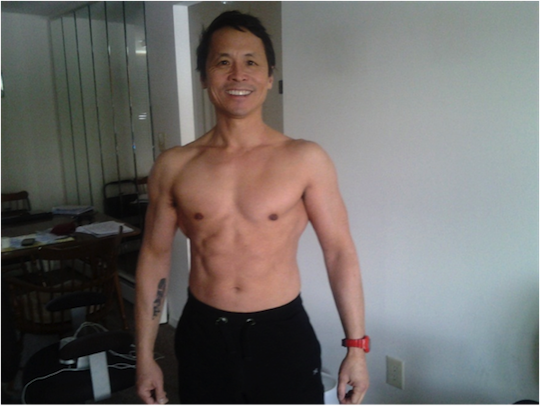
Subscribe to the Mark’s Daily Apple Newsletter and Get the Success Story in the Making eBook for Free

May 2, 2013
Do We Need Rites of Passage? – Part 2
 Ontogeny – the 25¢ word of the day, but you’re living it right now. From a strict biological perspective, ontogeny refers to the physical development of an organism from embryo to adult form. In a broader context (and more to the point here), it refers to the comprehensive development (e.g. physical, social, cognitive, spiritual) of an individual throughout the life cycle. Paul Shepherd discusses broader ontogeny at length in his book Coming Home to the Pleistocene, explaining “Because of our evolutionary past and the extraordinary way life has shaped our mind and bodies, we are required by the genome to proceed along a path of roles, perceptions, performances, understandings, and needs, none of which is specifically detailed by the genome but must be presented by the culture.” In other words, the progressive structure is there, waiting for our cultures to fill in the details and direct us through the scene changes. Do they? Do they need to? What happened to the social constructs to support these basic life transitions? What happened to rites of passage?
Ontogeny – the 25¢ word of the day, but you’re living it right now. From a strict biological perspective, ontogeny refers to the physical development of an organism from embryo to adult form. In a broader context (and more to the point here), it refers to the comprehensive development (e.g. physical, social, cognitive, spiritual) of an individual throughout the life cycle. Paul Shepherd discusses broader ontogeny at length in his book Coming Home to the Pleistocene, explaining “Because of our evolutionary past and the extraordinary way life has shaped our mind and bodies, we are required by the genome to proceed along a path of roles, perceptions, performances, understandings, and needs, none of which is specifically detailed by the genome but must be presented by the culture.” In other words, the progressive structure is there, waiting for our cultures to fill in the details and direct us through the scene changes. Do they? Do they need to? What happened to the social constructs to support these basic life transitions? What happened to rites of passage?
Ethnographers have long observed how communities observe life transitions, including the coming-of-age, threshold to manhood/womanhood, marriage, parenthood, and elderhood in addition to specific role transitions (leader, shaman/healer). Although the means involved in some of these rituals can range from intriguing but perhaps harrowing (Aborigine walkabout) to shockingly violent (mutilation rituals), in the observance itself there’s clarity, purpose, affirmation, belonging.
French ethnographer Arnold van Gennep’s seminal work, The Rites of Passage, examined the social ceremonies of these life stage/status events. He observed a common set of steps – separation, transition, and incorporation – that defined the process of these rites. The individual, in anticipation of the change is separated from the community. The transition can vary but marks the events/challenges/choices that bring about the change in stage/status itself. Finally, the individual is actively and respectfully reincorporated into the society within the new role. In Gennep’s interpretation, these processes were social deaths and rebirths.
Although we moderns all witness each other growing up, gaining maturity (hopefully), and getting older, things are much different now. Shepard and a number of psychologists (from Jung to modern evolutionary psychologist Anthony Stevens) have argued that modern society has done away with the ceremonial observance and particularly with the community guidance/support that used to accompany peoples’ life transitions. We’re more confused and drifting for it – as individuals and communities, they suggest. Life transitions, formally seen as socially significant and beneficial to the community, are now experienced as individually focused, even emotionally isolating events.
I explored this topic in a blog post late last year. I find this a fascinating topic because I do think something has been lost. Although our present cultures are supposed to fill in the “content” of these passages, I wonder how many of us feel supported through the full process of change. Therapy, as beneficial as it is for many life struggles, shouldn’t have to be a stand-in for normal life transitions. Left to our own devices in these shifting stages, we might feel separated. Many of us will likely feel the bewilderment of the “liminal” transition stage, when we’re entering a new phase or role in our lives (e.g. parenthood, middle age, empty nester, retirement, etc.). Finally, what does “reincorporation” look like in our modern culture? Do we find our own way back to the fold? Do we feel the same enhanced sense of belonging and new purpose? How much more effort and struggle and maybe even shame do we put ourselves through than if the passage were situated culturally in the same way? I don’t really have any specific or “should” kinds of answers to these questions, but I think they’re worth asking – intriguing if nothing else.
It’s not that we don’t understand the arc of development. Theorists like Erik and Joan Erikson, among others, have written extensively about developmental stages and the life cycle. For Erikson’s part, he suggested a series of stages and the core conflicts inherent to each (e.g. young adulthood – intimacy vs. isolation, adulthood – generativity vs. stagnation, old age – ego integrity vs. despair). Nonetheless, there’s a difference between intellectualizing the concept theoretically and practicing it communally.
These days “life crises” keep piling up in the popular imagination. No more are we just talking midlife crises (a post unto itself). Quarter life crisis is part of the common vernacular now. I’ve even heard people talk lately of a “one-third” life crisis. (That one doesn’t roll off the tongue quite as smoothly.) On the one hand, you could argue we’re becoming a more indulged and whining society. On the other, you could say we’ve never been further estranged from the age-old social constructs that could circumscribe and define the legitimate conflicts and core experiences involved in these “crisis” intervals. As the philosopher Kierkegaard said, “Life must be remembered backward, but lived forward.” We only see the significance of these life shifts in retrospect. Hence, there’s a significance to the cultural rites that traditionally guide each community member through a significant passage. As with most modern disturbances, the developmental phenomena are natural – primal. The problem comes in the mismatch between our elemental make-up and our contemporary environment.
How, then, do we bridge the psychic gap as moderns? How do we usher ourselves more confidently through life’s passages? How do we find community, if not ritual, to offer context in the midst of life challenges and changes?
Did you read my first article on this topic back in November? Did you take it to heart and explore rites of passage in your own life or your family members’ lives? If so, what has that looked like? Thanks for reading today, everyone.
Grab a Copy of The Primal Connection: Follow Your Genetic Blueprint to Health and Happiness Today!

May 1, 2013
How to Get Fitter, Faster and Stronger with Quality Sleep
 Ah, sleep. We all know how much we need it, mostly because when we don’t get enough, the world takes on a different, more negative hue. Lights seem brighter and sounds more vivid, and not in a good way. Perpetual fogginess clouds our thoughts, slurs our words, and prevents us from focusing on anything but the coffee pot timer. And then there’s the sleep deprivation research corroborating our experiences and explaining in lurid detail just how vital sleep is for our health. I’ve done my part in bringing this information to you, focusing for the most part on the metabolic health benefits of getting sufficient quality time with everyone’s sweet slumbery mistress. I’ve linked to articles discussing the links between poor sleep and ill liver health, disrupted metabolic function, and cancer. If you’re a regular reader of MDA, you’re probably aware of all this. Bad sleep can make you fat, sick, and prone to serious degenerative diseases.
Ah, sleep. We all know how much we need it, mostly because when we don’t get enough, the world takes on a different, more negative hue. Lights seem brighter and sounds more vivid, and not in a good way. Perpetual fogginess clouds our thoughts, slurs our words, and prevents us from focusing on anything but the coffee pot timer. And then there’s the sleep deprivation research corroborating our experiences and explaining in lurid detail just how vital sleep is for our health. I’ve done my part in bringing this information to you, focusing for the most part on the metabolic health benefits of getting sufficient quality time with everyone’s sweet slumbery mistress. I’ve linked to articles discussing the links between poor sleep and ill liver health, disrupted metabolic function, and cancer. If you’re a regular reader of MDA, you’re probably aware of all this. Bad sleep can make you fat, sick, and prone to serious degenerative diseases.
That’s not the focus of today’s post, though. Today is for the people who miss out on sleep to catch an early morning workout, who stay up late reading fitness blogs and trading fitness memes on Reddit, who tell themselves that all that yawning they do in between squat sets is just weakness leaving the body. Did you know that sleep deprivation also hampers our athletic performance? That bad sleep makes us slower, weaker, and less coordinated? That sleep deprivation reduces the effectiveness of our workouts, and sometimes even reverses their beneficial effects? That it can hamper our ability to build lean mass?
Let’s look at some of the research.
Sleep and Muscle Mass
Lean mass accrual is a common motivation among fitness enthusiasts. Muscle looks good, makes us stronger, tends to accompany other benefits like increased bone density and fat loss, and helps keep us alive longer. There are a few lines of evidence suggesting that sleep loss increases the loss of lean mass and makes it harder to build it in response to exercise.
One older study found that total sleep deprivation increases urinary excretion of nitrogen, which could be indicative of muscle breakdown and loss of lean mass.
Sleep-deprived rats experienced muscular atrophy, an effect that appeared to be mediated by decreases in testosterone and increases in corticosterone (the “rat cortisol”).
A more recent one found that insufficient sleep curtailed the efforts of obese human subjects to lose body weight and retain lean mass. Compared to the control group, the bad sleep group saw their lean body mass losses increase by 60% and their fat mass losses decrease by 55%. Markers of fat oxidation were reduced as well, suggesting that lean mass was being broken down into amino acids for energy.
Simply put, lack of sleep is a potent stressor, which means it increases the catabolic glucocorticoid family of hormones like cortisol and decreases the anabolic triad of testosterone, IGF-1, and growth hormone, effectively accentuating the “degradation pathways” while reducing the “protein synthesis pathways.” Few of us are experiencing the total sleep deprivation of 24-36 hours used in some of these studies, but 5-6 hour nights – chronic low-level sleep deprivation, the kind that’s endemic nowadays – do add up and exert many of the same effects, as shown in the study on obese humans limited to 5.5 hours a night.
Sleep and Performance
The effect of sleep deprivation on physical performance can’t be neatly summed up with a few tidy sentences. Sometimes it impairs performance and sometimes it has no effect at all. It really depends on what you’re measuring and what the subjects are actually doing. For endurance work, acute sleep deprivation doesn’t impair performance as much as you’d think, whereas for activities that demand greater motor control (like basketball or volleyball) or greater power output, acute sleep deprivation may have more negative effects. Let’s look at some of the studies that have been conducted.
One night of sleep deprivation reduced the amount of air taken into and expelled from the lungs during exercise in endurance runners and volleyball players. It also decreased the time until exhaustion, more so in the volleyball players.
30 hours of sleep loss hampered maximal output, but not endurance.
Anaerobic performance was impaired by 36 hours of wakefulness, while 24 hours had no effect.
Partial sleep loss (2.5 hours total sleep) had no effect on maximal muscle strength in women.
Severe (120 hour) sleep deprivation reduced the aerobic oxidation capacity in skeletal muscles and accentuated their reliance on the glycolytic pathway, effectively turning otherwise healthy skeletal muscles into pre-diabetic muscles.
24 hours of wakefulness did not have an adverse effect on the performance of collegiate weightlifters.
Sleep loss reduces tolerance of prolonged exercise, via psychological rather than physical avenues. End result is the same, I’d argue.
Sleep loss reduced sprint performance by lowering muscle glycogen content.
Of course, that’s just talking about acute sleep deprivation, like going a night or two without sleep. That type of sleep deprivation is easy and inexpensive to study, because you only need the subjects for a day or two, but I’d argue that it isn’t very relevant to most people’s concerns. What I’m interested in are the effects of chronic sleep deprivation, like getting six hours of sleep every night for a year. Many, perhaps most, people are getting suboptimal sleep on a nightly basis. That’s tougher to study, because you need to track subjects for days, weeks, or (ideally) months and years (an expensive undertaking), but I think you can make some educated guesses:
Consider that during slow wave sleep, growth hormone is released to build muscle and repair tissue damage. If you’re not sleeping, or your sleep is disrupted, you’re going to limit slow wave sleep (which already begins to decrease in duration the older you get) and therefore limit your body’s ability to recover from and adapt to your training.
Consider the protein-wasting, lean mass-catabolizing characteristics of sleep deprivation described earlier. A big part of adapting to training and improving performance is the increase in lean mass that usually accompanies exercise. If you’re not sleeping, you’re limiting your ability to pack on lean mass and increase performance.
Consider the increased cortisol and decreased testosterone associated with bad sleep. A high cortisol:testosterone ratio is strongly linked to “declines in the maximal voluntary neuromuscular performance capacity.”
And finally, consider that getting more sleep than normal, or accruing sleep surplus, has repeatedly been shown to increase physical performance:
In a study, aiming for at least ten hours of bedtime each night over several weeks improved the Stanford men’s basketball team’s free throw and three point field goal percentages.
In swimmers, six to seven weeks of ten hours of sleep a night decreased their 15-meter sprint time by half a second, increased their speed off the blocks, improved their turn time, and increased their kick stroke by five kicks.
In college football players, six to seven weeks of ten hours of sleep a night decreased their shuttle run and 40-yard dash times.
What does this mean, in practical terms?
To get the most out of your workouts, and to be the best you can be, you need more sleep. Aim for ten hours, an unrealistic goal for most, but a worthy one nonetheless.
If you can avoid it, work out at a reasonable time that allows you enough sleep. Skipping sleep to exercise may be counterproductive, or at least less effective than working out at a time that allows sleep. If you absolutely need your daily morning WOD, go to bed early enough to make up for it.
Take naps when and where you can. Sleep adds up, no matter where it comes from.
As training intensity or volume increase, so too must sleep. There isn’t an easy formula or anything. Just sleep more.
Eliminate sleep impediments. Follow the usual best sleep practices we’ve talked about before.
That’s all well and good, but not everyone can get perfect sleep all the time. In the event of an unavoidable night of bad sleep, what can you do to ameliorate the negative effects on performance the next day?
Meditate. Meditation is an effective counterbalance to the negative cognitive effects of poor sleep, some of which include hampered reaction times.
Drink coffee. As always, caffeine is a dependable stalwart. It increases the “voluntarily chosen resistance training load” after a night of poor sleep, for one.
Take creatine. Creatine has also been shown to reduce the negative effects of a poor night’s sleep on performance about as well as caffeine.
We all know how much sleep matters, but we rarely think about its effect on our strength and fitness. Hopefully this post helps you realize the extent of its reach. If you want optimal results, you cannot compromise on sleep, nor can you train your way out of a deficit.
Thanks for reading, folks!
Not Sure What to Eat? Get the Primal Blueprint Meal Plan for Shopping Lists and Recipes Delivered Directly to Your Inbox Each Week

New Mark’s Daily Apple Forum App

I’m pleased to announce a free smart phone and tablet app for the Mark’s Daily Apple Forum. I’ve been using it for the last week and have found that it makes browsing, reading and writing in the forum on smart devices a cinch.
If you’re not familiar with the forum, this is the perfect time to create an account and connect with the Mark’s Daily Apple community. There’s no better place to communicate with and get outstanding feedback from fellow paleo/Primal enthusiasts.
Here are a few screenshots of the new app (click to enlarge):
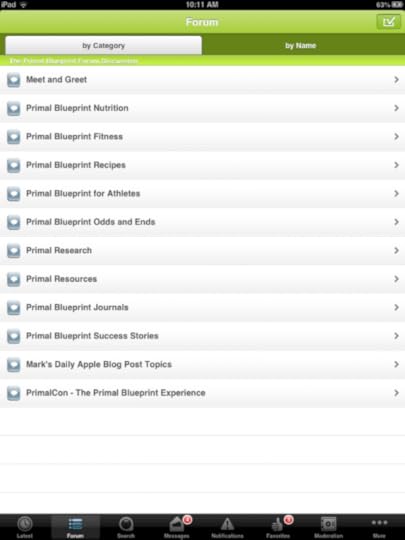
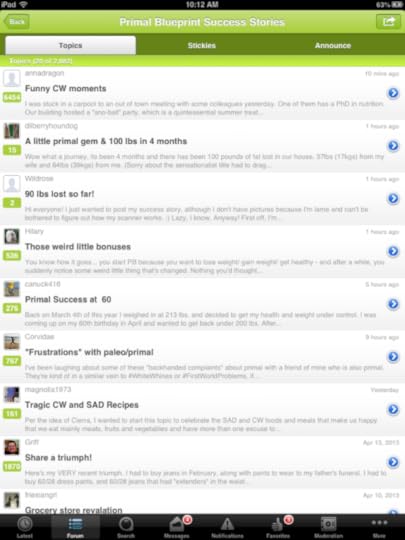

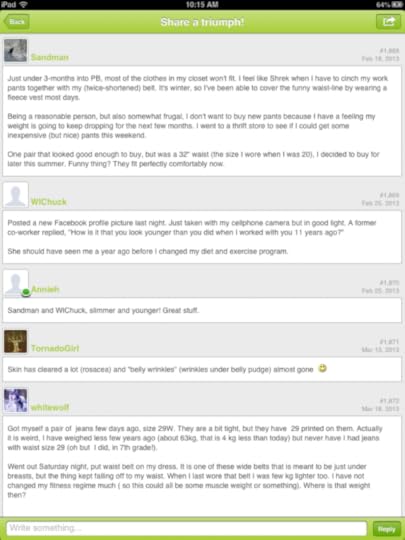
You can get the Mark’s Daily Apple Forum app for the iPhone and iPad here and for Android devices here.
If you give the app a spin, I’d really appreciate if you review it in the iTunes and Google Play stores. Many thanks in advance.
I hope this makes the MDA experience even better for everyone that visits. Enjoy!

April 30, 2013
Crawling, Balancing, Rolling: The Importance of Practicing Natural Movements
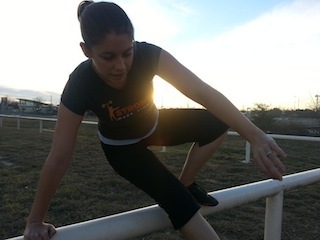 This is a guest post from Tracy Barksdale co-founder of True Nature Training. Tracy will be presenting at The Primal Blueprint Transformation Seminar and True Nature Training in Austin and Houston, Texas this coming May 4th and 5th.
This is a guest post from Tracy Barksdale co-founder of True Nature Training. Tracy will be presenting at The Primal Blueprint Transformation Seminar and True Nature Training in Austin and Houston, Texas this coming May 4th and 5th.
My job is essentially to get people to have fun. I am a Natural Movement and Parkour coach at True Nature Training who uses play and unconventional programming to get people active without realizing they are getting a workout. It’s so common to get stuck in our fitness routines. Push ups, pull ups, squats, and sprints are all obvious choices for a primal fitness program, but when we get bored or hit a plateau it can help to widen your repertoire to introduce new things. In many cases, this great “new thing” is actually very old. Natural movement is a movement philosophy based on natural human movements that we have evolved doing. Our ancestors had to crawl, climb, run, jump and more just to survive. Yet with our modern luxuries, we often don’t find ourselves needing to do these things as often. It’s not uncommon to hear someone proclaim with a hint of pride that they have not climbed a tree since they were kids, like it’s a sign of being a mature adult. Natural movements are not just for kids or those who are already active. Natural movement belongs to every human being, and it’s your duty to maintain proficiency in these practical movements because you never know when you may need to use them. Here are some movements that can benefit anyone regardless of age or fitness level.
Crawling
Crawling is amazing. You connect to the earth, it’s a whole body movement, and it requires coordination. Babies instinctively crawl yet once walking is established, crawling is rarely used. Quadrupedal movements (moving on all fours) have many practical applications. Crawling can be used for getting under something low like a table or car, avoiding a dangerous situation where you might need to duck and get out low and quick, or just lowering your center of gravity while on an unstable surface.
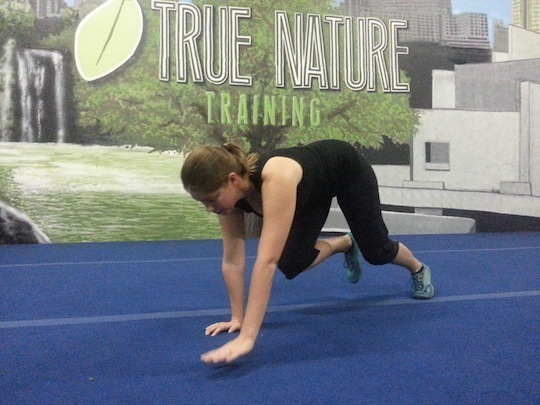
Let’s look at a basic bear crawl. To begin, start on the ground on your hands and knees. Your hands should be directly under your shoulders and knees under your hips. Bring your heels up so you can use your toes to move. Next, apply pressure in your hands and pop your knees off the ground around 4 inches. Your back should be roughly parallel to the ground. You want to maintain this level throughout your crawl. To begin crawling, move in a contralateral pattern (opposite hand and foot.) Move your right hand forward and left foot forward at the same time. Then switch. Left hand forward, right foot forward. Look in front of you to see where you are going, but only lift your head as much as necessary to see. Be careful not to let your knees flare out to the side. To make sure your knees are properly aligned, keep your knee in line with your elbow.
Balancing
Balancing is a skill that is rarely practiced yet is another very practical movement. The elderly especially can benefit from balance work, but why wait till you’re old? Train balance now because you never know when you may need to use it. Balancing is really the state of not falling. You’re balancing when you’re standing, when you’re lying down, and when you’re walking on a ledge. It’s about being in control of your body positioning.
To practice balance, find a curb outside or grab a couple 2x4s to put in your house. Stand on the surface, find a tall proper posture, and look forward, not down. Use your feet (preferably bare feet) to feel your surface before you take a step. Keep your knees “soft” meaning not straight, but not completely bent. Keeping a slight bend in the knees allows for more control and encourages adjustments to be made in your knees, ankles and feet instead of flailing your arms to get balance which tends to be a waste of energy. Practice balancing forward, backward, sideways, crawling and any other ways you can imagine. Oh, and remember to breathe! Many people revert to shallow breathing or hold their breath while balancing. Make sure to practice diaphragmatic breathing at all times while balancing.
Rolling
When is the last time you rolled in the grass? Forward roll, barrel roll, backward roll? Besides being a fun and playful skill, it can also be a very practical skill to have. Rolling can be used to absorb impact when jumping from something high, or in case of tripping, rolling is often a better option than hitting the ground. Rolling requires coordination and is an excellent tool to further develop the vestibular system. For example, if you were in a situation where you needed to balance over something high, narrow and scary, you could very likely be under a lot of pressure and you could feel dizzy. Training the vestibular system further ensures that you are prepared for possible real world situations.
To begin rolling, a movement pattern must first be established before being used in combination with falls and depth jumps. To get started, kneel down on one knee, hips up, not sitting on your back foot. Place your hands side by side flat on the floor next to your foot. Move your hands away from your foot and forward so that you are set up similar to the first picture below.
Next, twist your hands away from your front foot and look at your back foot in the same direction your hands are pointed, tucking your chin and getting your head out of the way to roll as in the second photo.

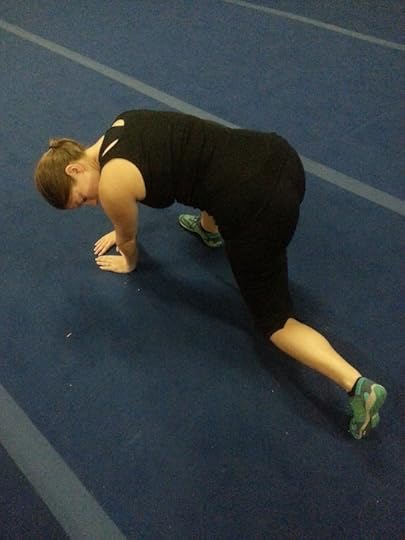
Last, push through your back foot raising your hips in the air. Your head should be out of the way from looking at your foot, and you are prepared to roll directly onto the shoulder. Keep pushing until you must roll over your shoulder. Do not roll over your neck or head.
When you come out of the roll, you should pass over the opposite hip as the shoulder your rolled on.
To finish, you should end in the same position you started in. So if you began with your right knee up, you should end in that position.
Check out this video sequence to see what I mean:
Play
Although technique is of course very important, it’s also vital that you have fun. It’s okay to jump around on rocks or climb some trees without thinking about the mechanics and exact techniques you should be using. Just remember Law #9 and Avoid Stupid Mistakes. Go outside with your kids or grab some friends and play tag. If you aren’t enjoying yourself and having fun, you won’t stick to it. Incorporating play into your movement practice is just as vital as working out and eating right. Play helps reduce stress, encourage movement, and in turn helps keep you refreshed and motivated to eat right. So make sure to do what you enjoy, laugh at yourself when you mess up, and get creative in whatever environment you find yourself in whether it be your office, a park, your house or the gym.
These movements can help you round out your training or even help you get moving again. Let your world be your playground and find ways to move everywhere. Hand rails, curbs, rocks, and playground equipment are all great opportunities for movement. Look to your community for natural movement practitioners or better yet, come join me for a Primal Blueprint Transformation Seminar. I’ll be teaching natural movement and this is an excellent way to get an introduction or refresher.
Join Tracy Barksdale and Other Primal Enthusiasts on May 4th in Austin, TX and May 5th in Houston, TX for a Full-Day Seminar You Won’t Forget

April 29, 2013
Dear Mark: Protein for Pregnancy and Nursing, Reversing Sun Damage, Inflammatory Eggs
 It’s Monday, which means it’s time for another edition of Dear Mark. This time, I’m covering three topics. First up is optimal protein intake for breastfeeding and pregnant women. I’m not sure how I forgot to include those groups in last week’s protein post, but I did, and you guys called me out on it. Then, I discuss several different topical supplements you can try for reducing UV-induced skin damage. There may be damage that simply can’t be reversed, but I suspect you can improve the situation to some extent. And finally, I field a question from a reader who’s worried about eggs being inflammatory. It seems he’s just read a book whose author classifies over 2,000 foods by their “inflammation factor,” and eggs scored really, really low (i.e. bad).
It’s Monday, which means it’s time for another edition of Dear Mark. This time, I’m covering three topics. First up is optimal protein intake for breastfeeding and pregnant women. I’m not sure how I forgot to include those groups in last week’s protein post, but I did, and you guys called me out on it. Then, I discuss several different topical supplements you can try for reducing UV-induced skin damage. There may be damage that simply can’t be reversed, but I suspect you can improve the situation to some extent. And finally, I field a question from a reader who’s worried about eggs being inflammatory. It seems he’s just read a book whose author classifies over 2,000 foods by their “inflammation factor,” and eggs scored really, really low (i.e. bad).
Let’s get to it:
What about protein intake for pregnant and/or breastfeeding mammas? Over the past 3 years I have between either one or both of those.
Kelly
It’s difficult to find “grams per pound of bodyweight” recommendations, simply because you’re not really eating for just yourself during pregnancy – you’re actually building and supporting an entirely different human being growing inside you! Here’s what we do know about protein intake during pregnancy:
“Isocaloric protein supplementation,” where protein is substituted for equal caloric energy from another macronutrient, is associated with an increased risk of having a small-for-gestational-age baby (SGA). Underweight babies are at a greater risk of health issues, especially later on in life. So don’t drop the fat and/or carbs in favor of more protein.
“High protein supplementation,” where protein is increased to 25% or more of total calories, is associated with a nonsignificant reduction in mean birthweight, a significantly increased risk of SGA birth, and a nonsignificantly increased risk of neonatal death. One study even found that the offspring of mothers on a high-protein pregnancy diet were more susceptible to stress, tending to release more cortisol when exposed to psychological stressors than offspring of mothers on a lower protein diet. Don’t do a protein sparing modified fast (high protein, low calorie, low fat, low carb diet bodybuilders use to cut) while pregnant.
Energy and protein restriction for overweight pregnant ladies reduced both maternal and baby weight without improving hypertension or preeclampsia. You know what? Don’t diet at all when you’re pregnant.
Balanced protein energy supplementation, however, seems to be helpful. That’s where you eat sufficient protein and overall calories while keeping protein under 25% of calories. Particularly in undernourished pregnant women, balanced protein energy supplementation decreases the risk of SGA. In other words, eating protein as part of a balanced overall diet is best, while eating an explicitly high-protein diet is probably ill-advised.
Don’t avoid or consciously limit protein when pregnant, of course. Why, during the first trimester, protein meals can even reduce nausea. Eat to appetite. Follow your protein cravings. From what I can tell, undernourished women will naturally desire more protein during pregnancy (take the common phenomenon of the vegan suddenly craving rare steak during the first trimester) while women who are already getting enough protein to support their pregnancy will crave it less. That’s fine.
As for nursing women, protein needs will definitely increase because you’re producing nearly a liter of protein-containing breast milk a day. Now, human milk isn’t particularly protein-rich – it’s 14–16 g/L during early lactation, 8–10 g/L at 3–4 mo of lactation, and 7–8 g/L at 6 months and later – but it does have a significant amount of “non protein nitrogen.” Non protein nitrogen still has to be produced by the mother from dietary protein. Some sources suggest an increase of 20 grams protein per day is enough. I think what’s important is overall caloric intake from healthy Primal foods. You don’t want to eat so few calories that you have to resort to burning amino acids for energy or converting protein into glucose.
Except for being more cautious about sun exposure in the future, are there any tips on how to manage the problems of damaged skin and minimising future damage? Someone on the forums mentioned vitamin E oil and the primal favourite, coconut oil, to aid skin recovery, would you agree? Thanks!
Jack
Be sure to check out the two posts I did a couple years ago on preventing and treating sunburns. Those tips will be helpful, particularly in prevention. As for treating damaged skin, there are some things you can try. I can’t personally vouch for any of these, but I’ll present the evidence for each and let you decide what to try. At the worst, they just won’t work and you can move on to the next one. They certainly won’t hurt to try (with perhaps one exception), though. Sound good?
Curcumin, the “active” ingredient in turmeric, seems to be effective at healing sun damaged skin. Both oral and topical supplementation appears to help improve resistance to the development of skin cancer.
A “fruit blend” of sea buckthorn extract, blueberry extract, and collagen prevented skin aging in hairless mice subjected to 6 weeks of UV radiation.
Topical testosterone, progesterone, and pregnenolone all reduced the symptoms of aging in actual human skin (still attached to humans). They reduced wrinkling, restored hair growth, and restored sweating capability (PDF). Meanwhile, topical estrogen sped up the aging process, and topical stress hormones sped it up even more. Hormones aren’t to be trifled with lightly, though, so don’t mess around with these unless you know you’re doing or under the guidance of someone who does.
Topical vitamin C has been shown to improve collagen synthesis (important for restoring the quality of skin), reduce hyperpigmentation, and act as an anti-inflammatory agent to many skin disorders. Furthermore, it can protect you from UV damage in the first place. Unfortunately, vitamin C is somewhat unstable, so making your own ointment, balm, salve, or serum can be a way to make sure yours is active and effective.
Topical retinol, a popular component of skin creams, improves the quality and appearance of photo-aged human skin. Topical retinoids have also been shown to manage acne, psoriasis, photoaging, and cutaneous T-cell lymphoma. If you’re averse to the use of skin creams, I suppose you could always go to sleep with a polar bear liver mask.
Topical vitamin B3 in the form of niacinamide reduced the prevalence and intensity of sun spots in women aged 40-60.
I couldn’t find much on vitamin E or coconut oil as agents of sun damage reversal. Can’t hurt to moisturize with a bit of coconut oil, of course. Red palm oil might work even better, as it’s a rich source of both vitamin E and vitamin A (in the form of carotenoids). Only problem is it stains clothes, if you apply it topically.
Hope you find something that helps!
Hi Mark, I took the time to copy Monica Reinagel’s entire list of foods and their “inflammation factor”, and this list has eggs as one of the most inflammatory foods on the entire list of 2100 items. Any idea why? Is she just off base? Maybe she is talking about eggs from factory farms? I love eggs and eat them a lot, so I’m concerned.
Thanks,
Mark
Hey Mark, cool name!
I just checked out her “inflammation factor formula” to see how she arrives at her conclusions. It “includes more than 20 different factors that affect a food’s inflammatory or anti-inflammatory potential,” such as the amount and types of fat (more is worse, I’m guessing, and saturated fats are particularly dangerous), the presence of essential fatty acids (like linoleic acid, of course), the vitamins, minerals, and antioxidants, the glycemic index, and the anti-inflammatory compounds present in the food. The lower the IF rating, the more inflammatory the food. An egg yolk has an IF rating of -173, more inflammatory than french fries (-51), white flour (-142), and corn oil (-54).
I’m trying to figure out why she hates egg yolks so much. It could be the PUFAs, since she’s definitely aware of their inflammatory potential (high-PUFA linoleic sunflower oil runs -82 while high-MUFA sunflower oil runs 108). It could be the cholesterol; from a blog post detailing her diet plan, she seems to fear animal fat (“look for well-trimmed cuts” of red meat). She’s also not so crazy about grains (“grains aren’t needed”) and prefers that people focus on protein and vegetables. She even says two eggs a day are fine, highly inflammatory yolks included. I’m not really sure what to make of it. It all ends up sounding like your typical low-fat, low-carb, high-protein recipe for metabolic disaster.
Anyway, you were worried about eggs. After all, she had to arrive at that -173 because of something, right?
Battery-fed eggs definitely aren’t as healthy as pasture-fed eggs, with one study even showing that hens fed high-omega-6 diets (corn and soy) produced eggs that led to increased levels of oxidized LDL in people who ate them. And pasture-fed eggs contain more vitamin E, more omega-3s, and more vitamin A, among other nutrients. Reinagel almost certainly used standard eggs to render her decisions.
Bottom line: eggs are healthy. They just are. For all the studies Reinagel has apparently poured over to support her classification of egg yolks as extremely inflammatory, eggs have never been shown to be unhealthy. They are the best source of choline (save for perhaps brain), an essential nutrient that protects us from fatty liver (or is having a fatty liver anti-inflammatory?) and helps build robust baby brains. They are full of vitamin A and vitamin E and iodine and selenium. They contain highly available protein. They’re strongly associated with beneficial metabolic effects when compared to egg substitutes (which, sure enough, gets a certified anti-inflammatory IF rating of 13). That’s what you should be thinking about, not some arcane rating system that apparently fails to take all relevant criteria into account.
Enjoy your eggs.
That’s it for today, guys. Thanks for reading and be sure to leave a comment!
Not Sure What to Eat? Get the Primal Blueprint Meal Plan for Shopping Lists and Recipes Delivered Directly to Your Inbox Each Week

Mark Sisson's Blog
- Mark Sisson's profile
- 199 followers



